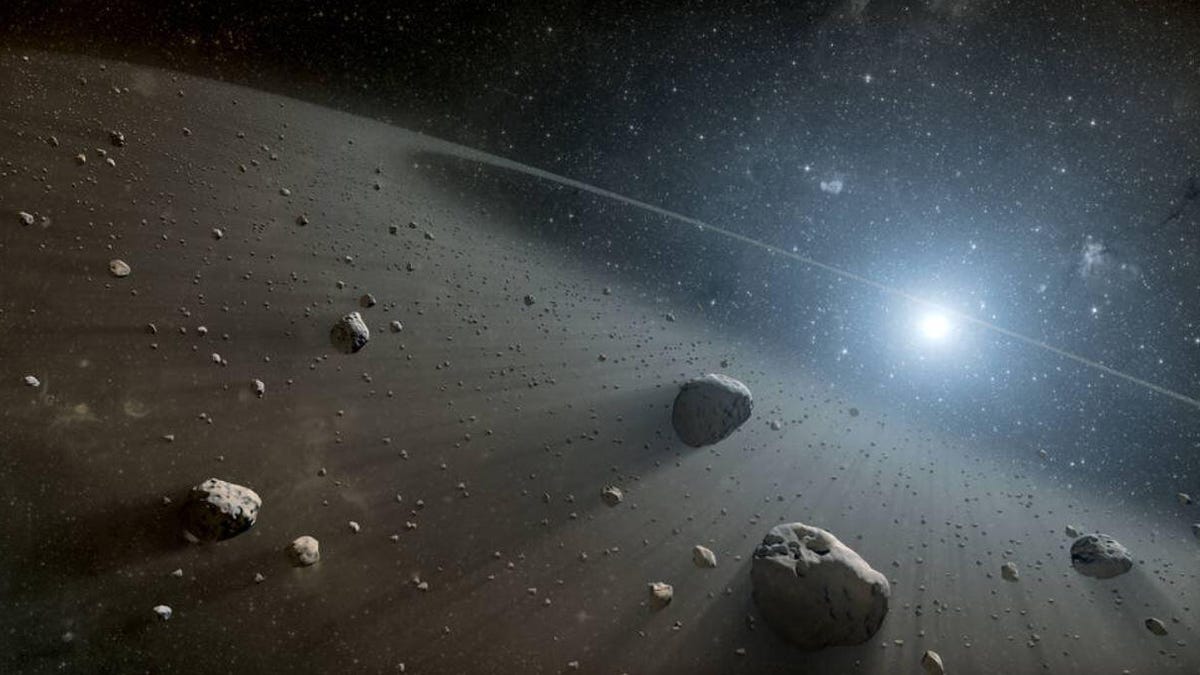Rare asteroids near Earth may contain precious metals worth $11.65 trillion
These priceless chunks could be targets for future space mining and offer clues about an even greater cosmic treasure.

An artist's rendering of asteroids in the asteroid belt.
Scientists just calculated that one of two metallic asteroids floating in Earth's vicinity may contain precious metals worth about $11.65 trillion. The expensive nugget, in fact, could boast more iron, nickel and cobalt than the entirety of our global metal reserves.
Called metal-rich near-Earth asteroids, these rare, hefty mineral deposits measure over a mile wide. The one reckoned to be a metal motherlode is labeled 1986 DA, and the other, 2016 ED85.
The duo "could be possible targets for asteroid mining in the future," according to the new analysis published Friday in The Planetary Science Journal.
Space mining has gained traction in the scientific community because experts believe the feat could provide cost-effective metals for a lunar or Mars-based colony, ultimately extending humanity's reach in exploring space. With a cosmic mine, building materials wouldn't have to withstand the expensive shuttle from Earth to space.
Further, the team behind the math suggests these unique floating orbs may shed much-needed light on the authenticity of another metallic treasure NASA is headed to in 2022 -- the mysterious shiny space globe known as 16 Psyche.
16 Psyche has its own allure for space mining enthusiasts.
An artist's illustration shows what asteroid 16 Psyche might look like.
Instead of trees, oceans or stretches of soil, the bizarre body is thought to consist of hills and valleys made of pure metal. Scientists contend it's the remaining core of an ancient rocky planet that was once destroyed. Interestingly, Earth's covered-up core looks awfully similar.
Aptly dubbed "mini Psyches," the valuable smaller asteroids described in the new study are presumably pieces that have broken off from a similar naked center, though the research team notes they don't think these fragments are offshoots of 16 Psyche in particular.
Still, 16 Psyche has become a rather hot topic of discussion among scientists and even the public -- it's suspected to hold minerals worth $10,000 quadrillion. Let that sink in.
The exorbitant figure, however, has generated considerable doubt because scientists can't be sure what 16 Psyche is made of until a spacecraft inspects it. It's too far away for precise spectrum analysis, a scientific method that leverages electromagnetic emission and absorption signals to learn about objects' compositions.
Until such an examination can happen, something NASA's mission intends to perform, researchers have to consider the option that it's merely some sort of rubble.
That's what makes data from the "mini Psyches" indispensable -- they may offer a first look at their namesake's features. Proximity to our home planet deems it much easier for scientists to capture the rocks' spectral info from Earth.
"It is rewarding that we have discovered these 'mini Psyches' so close to the Earth," Vishnu Reddy, associate professor at the University of Arizona's Lunar and Planetary Laboratory and principal investigator of the NASA grant that funded the work, said in a statement.
Sifting through the collected data, researchers found the orbiting blocks are made of 85% metal, such as iron and nickel, and only 15% silicate, which is basically regular rock.
As such, some ambiguity about 16 Psyche might soon be alleviated thanks to the baby versions of it -- including whether it'll add to the crew of treasure troves for future space miners.
Regardless, while the trio of metallic hunks definitely seem to hint at our sci-fi fantasies of space mining inching toward reality, one thing is absolutely certain: They're a pretty hard-core squad.

